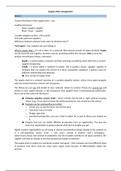Supply chain management
Week 2
‘toward the theory of the supply chain’- case
Coalition behaviour
- Buyer-supplier-supplier
- Buyer- buyer – supplier
Complex adaptive system - CAS system?
VMI with upstream suppliers
Difference between physical notes and non-physical ones??
Focal agent = the company you are looking at
What is supply chain = It’s not a chain, it’s a network. This network consists of nodes and links. Nodes
are the factories and suppliers, business that do something within this network, links is were the
product actually goes (shops, customers)
- Dyadic = 2 actors within a network and they exchange something. Most often this is a buyer-
supplier relationship
- Triadic = 3 actors within a network (3 nodes). This is usually a buyer- supplier- supplier (a
company that can acquire the service of 2 other companies/ suppliers). 3 parties cause for
different relationships and dynamics
key concept of supply chain
The supply chain as a network operates as a complex adaptive system, where every agent grapples
with the tension between control and emergence
The things you can see and predict in your network, relates to control. Things you cannot see and
predict in your supply network, is the emergence (one supplier faces a manufacturing malfunction,
this is out of the control of the buyer)
Complex adaptive system (CAS) = think of birds that fly left or right without knowing
where to go. If you want to know the whole perspective, you should use this system
Example can be a perspective on a chair;
o Visual; you can see the front, but not the back
o Technical; how is it made
o Design; ugly chair
o Functional perspective; you use a chair to either sit, or just to throw your clothes on
it
Imagine how you can define different perspective from an organisation. The way you
look at an organisation is going to decide what kind of insights you get
Agents (nodes/ organisation) are all trying to control and therefore things emerge in the network its
is a self-organizing system (CAS) -> one man’s control is another man’s emergence
(when avans always had all kind of sandwiches, but all of sudden switches to all vegan sandwich, the
supplier will need to emerge to this new demand and adapt its network)
The supply chain is relative to a particular product and agent = One company can have different types
of products that don’t need the exact same supply chain because of differentiation within the
product.
, The supply chain consists of both a physical supply chain and a support supply chain;
1. Physical supply chain is the direct supply chain, it’s the actual flow of goods
2. Support supply chain, is the financial side. You need support of the bank because you
need to be able to purchase goods/ materials and pay for construction/ movement of the
goods. In this supply chain its not about the product you are making, they just support
the supply chain. They are indirectly involved
The supply chain is bounded by the visible horizon of the focal agent. This means that the visible
horizon of the focal agent is limited, because you can’t see how important you are. And how central
or not your position is within the network. You’re bounded by your own visible horizon. There is
only so much you can know about your own network, and it diminishes the further you get into the
network.
The visible horizon of the focal agent is subject to attenuation, where distance is based on factors
including physical distance, cultural distance and closeness centrality
The further you try to look in your network/ horizon the more foggy it gets. The less and
less visibility is not just physical distance (eg. China is far away), this distance is also
based on cultural distance between 2 countries/ companies/ suppliers
Week 3
“why research in sustainable supply chain management should have no future” – CASE
Sustainable supply chain management (SSCM) = the management of material, information and
capital flows as well as cooperation among companies along the supply chain while taking goals from
all three dimensions of sustainable development, i.e., economic, environmental and social, into
account which are derived from customer and stakeholder requirements.
Economic, environmental and social part is the core part of sustainability
o Getting economic profit
o Involve the social community
SSCM is the designing, organizing, coordinating, and controlling of supply chains to become
truly sustainable with the minimum expectation of a truly sustainable supply chain being to
maintain economic viability, while doing no harm to social or environmental systems
Both definitions focus on the triple bottom line; economic, environmental and social performance
- Triple bottom line; people/ planet/ profit
Use the term SSCM in its broadest fashion to encompass any research that accounts for both the
economic and noneconomic impacts of a supply chain. SSCM, in this context, includes all SCM
research that addresses the environmental or social components of performance, including research
that has been labelled as green, responsible, or ethical supply chain management
It's not sustainable to say that SSCM is a side job of the mainstream of SCM, because the entire
purpose is to include sustainability in the work
Issues with SCM;
1. Harm reduction is not harm elimination
Becoming less unsustainable is not becoming more sustainable. When you decide to behave
less unsustainable doesn’t automatically mean that you do behave sustainable, companies





